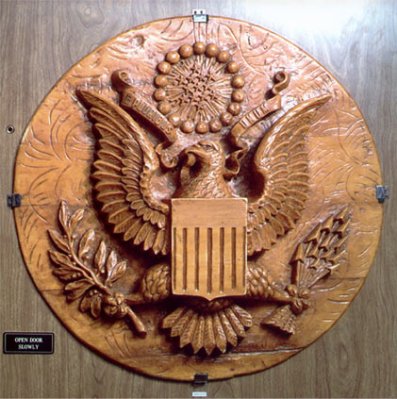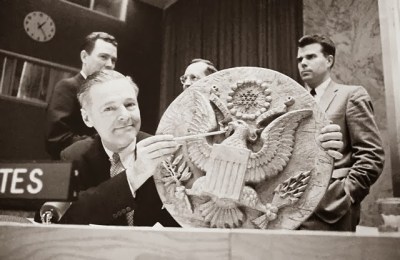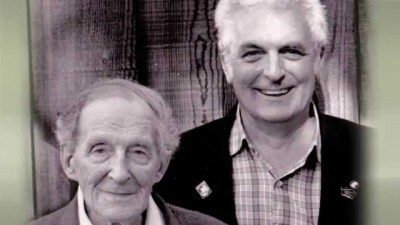Adam Fabio, hackaday.com; via JFS on Facebook

The man leaned over his creation, carefully assembling the tiny pieces. This was the hardest part, placing a thin silver plated diaphragm over the internal chamber. The diaphragm had to be strong enough to support itself, yet flexible enough to be affected by the slightest sound. One false move, and the device would be ruined. To fail meant a return to the road work detail, quite possibly a death sentence. Finally, the job was done. The man leaned back to admire his work.
The man in this semi-fictional vignette was Lev Sergeyevich Termen, better known in the western world as Léon Theremin. You know Theremin for the musical instrument which bears his name. In the spy business though, he is known as the creator of one of the most successful clandestine listening devices ever used against the American government.
 The creation of Léon Theremin’s bug can be attributed to the success of his instrument. Theremin, the man, was a scientist by training. Theremin,the instrument, uses the player’s hand proximity to a pair of antennas to generate electronic sound. As a young student, Theremin was an aspiring physicist. World War One saw him enter military engineering school for radio operations. After the war, he worked on experiments as diverse as a device to measure the dielectric constant of gases and hypnosis. Léon even did work in Ivan Pavlov’s lab.
The creation of Léon Theremin’s bug can be attributed to the success of his instrument. Theremin, the man, was a scientist by training. Theremin,the instrument, uses the player’s hand proximity to a pair of antennas to generate electronic sound. As a young student, Theremin was an aspiring physicist. World War One saw him enter military engineering school for radio operations. After the war, he worked on experiments as diverse as a device to measure the dielectric constant of gases and hypnosis. Léon even did work in Ivan Pavlov’s lab.
In 1920, while working on his dielectric measurement device, Theremin noticed that an audio oscillator changed frequency when he moved his hand near the circuit. The Theremin was born. In November of 1920 Léon gave his first public concert with the instrument. He began touring with it in the late 1920’s and in 1928, he brought the Theremin to the United States. He set up a lab in New York and worked with RCA to produce the instrument.
Theremin’s personal life during this period was less successful than his professional endeavors. His wife, Katia, had come to America with him and studied medicine at a school about 35 miles from the City. For much of this time, Léon and Katia lived apart, seeing each other only a couple of times a week. While at school, Katia became associated with a fascist organization. The Russian Consulate caught wind of this and summarily divorced Léon from Katia. They couldn’t risk their rising star being associated with the Nazis.
Theremin eventually remarried, this time to Lavinia Williams, a ballerina. Lavinia was African-American and the couple faced ridicule in American social circles due to their mixed race. However, the Soviet Consulate did not have a problem with their relationship. In 1938, with the Nazi threat growing stronger, Theremin returned to Russia. He expected to send for his wife a few weeks after his arrival. Unfortunately, that wasn’t to be the case. Léon and Lavinia never saw each other again.
Upon arrival in Leningrad, Theremin was imprisoned, suspected of crimes against the state. He found himself working in a laboratory for the state department [JB ????]. This was not an unusual situation. Aircraft designer Andrei Tupolev and missile designer Sergei Korolyov were two of many others who faced a similar fate.
It was during this time as a prisoner that Theremin designed his listening device.
It was during this time as a prisoner that Theremin designed his listening device.
Placing the bug
 The date was August 4, 1945. The european war was over, and the nuclear bombing of Hiroshima was only two days away. A group of 10 to 15 year old boys from the Young Pioneer Organization of the Soviet Union arrived at the US embassy carrying a hand carved great seal of the United States of America. They presented the seal to W. Averell Harriman, the US ambassador to the Soviet Union. The seal was given as a gesture of friendship between the US and Soviet Union. Harriman hung the plaque in the study of his residence, Spaso House. Unbeknownst to Harriman, the seal contained Theremin’s sophisticated listening device. The device, later known as “The Thing”, would not be discovered until 1952 — roughly seven years later.
The date was August 4, 1945. The european war was over, and the nuclear bombing of Hiroshima was only two days away. A group of 10 to 15 year old boys from the Young Pioneer Organization of the Soviet Union arrived at the US embassy carrying a hand carved great seal of the United States of America. They presented the seal to W. Averell Harriman, the US ambassador to the Soviet Union. The seal was given as a gesture of friendship between the US and Soviet Union. Harriman hung the plaque in the study of his residence, Spaso House. Unbeknownst to Harriman, the seal contained Theremin’s sophisticated listening device. The device, later known as “The Thing”, would not be discovered until 1952 — roughly seven years later.Discovered!
 The discovery of the great seal listening device is an interesting one. British broadcasters reported hearing American voices on the their radios in the vicinity of the American embassy. No Americans were transmitting though, which meant there had to be a bug. Numerous sweeps were performed, all of which turned up nothing. Joseph Bezjian had a hunch though. He stayed at the embassy pretending to be a house guest. His equipment was shipped in separately, disguised from Russian eyes. Powering up his equipment, Bezjian began a sweep of the building. With his receiver tuned to 1.6 GHz, he heard the bug’s audio, and quickly isolated the source in the great seal. Close inspection of the carving found it had been hollowed out, and a strange device placed behind the eagle’s beak. No batteries or wires were evident, and the device was not powered through the nail which had been hanging the seal. Bezjian removed the device from the great seal and was so cautious the he slept with it under his pillow that night for safe keeping. The next day he sent it back to Washington for analysis.
The discovery of the great seal listening device is an interesting one. British broadcasters reported hearing American voices on the their radios in the vicinity of the American embassy. No Americans were transmitting though, which meant there had to be a bug. Numerous sweeps were performed, all of which turned up nothing. Joseph Bezjian had a hunch though. He stayed at the embassy pretending to be a house guest. His equipment was shipped in separately, disguised from Russian eyes. Powering up his equipment, Bezjian began a sweep of the building. With his receiver tuned to 1.6 GHz, he heard the bug’s audio, and quickly isolated the source in the great seal. Close inspection of the carving found it had been hollowed out, and a strange device placed behind the eagle’s beak. No batteries or wires were evident, and the device was not powered through the nail which had been hanging the seal. Bezjian removed the device from the great seal and was so cautious the he slept with it under his pillow that night for safe keeping. The next day he sent it back to Washington for analysis.Theory of Operation
 The great seal bug quickly became known as “The Thing”. It was a passive resonant cavity device, containing no batteries or other power source. It consisted of an antenna and a small cylinder. One side of the cylinder was solid. The other side consisted of a very thin diaphragm, obviously some sort of microphone. Passive resonant cavities had been explored before, both in the US and abroad, but this is the first time we know of that was used for clandestine purposes. In his book Spycatcher, British operative Peter Wright claims that the US came to him for help determining how the device worked. However he is not mentioned in other accounts of Theremin’s bug.
The great seal bug quickly became known as “The Thing”. It was a passive resonant cavity device, containing no batteries or other power source. It consisted of an antenna and a small cylinder. One side of the cylinder was solid. The other side consisted of a very thin diaphragm, obviously some sort of microphone. Passive resonant cavities had been explored before, both in the US and abroad, but this is the first time we know of that was used for clandestine purposes. In his book Spycatcher, British operative Peter Wright claims that the US came to him for help determining how the device worked. However he is not mentioned in other accounts of Theremin’s bug.
Regardless of who figured out the device, the method of operation is devilishly simple. The Soviets would sit outside the embassy, either in another building or in a van. From this remote location they would aim a radio transmitter at the great seal. The bug inside would receive this signal and transmit voices in the room on a second, higher frequency. It did all of this with no standard internal components. No resistors, no tubes, no traditional capacitors, or the like. There were capacitive properties to the mechanism. For instance, a capacitor is formed between the diaphragm and the tuning peg of the device.
 Receive tuning (if it can be called such) was achieved by the precisely cut antenna. The RF carrier transmitted by the Russians would be received at the antenna and travel into the body of the device which was a resonant cavity. That resonant chamber was capacatively coupled to the thin conductive diaphragm which formed the microphone.
Receive tuning (if it can be called such) was achieved by the precisely cut antenna. The RF carrier transmitted by the Russians would be received at the antenna and travel into the body of the device which was a resonant cavity. That resonant chamber was capacatively coupled to the thin conductive diaphragm which formed the microphone.
Sound waves would cause the diaphragm to move, which would vary the capacitance between the body and diaphragm, forming a condenser microphone. It is important to note that the bug didn’t transmit and receive on the same frequency. According to Peter Wright, the excitation frequency used by the Russians was actually 800 MHz. The cavity would resonate at a multiple of this base frequency, producing the 1.6 GHz output seen by Bezjian.
While bugs of this type have fallen out of favor, the idea of “illuminating” a device with an external transmitter lives on. Check out [Elliot’s] description of the RageMaster bug from the ANT catalog here. Resonant cavities have found common use as well. Every microwave oven or radar system with a magnetron uses one.
A Political Pawn
 The great seal bug disappeared for a number of years. The Russians knew we had caught them, and moved on to other espionage devices. It finally reappeared in 1960 at the United Nations. During the Gary Powers U2 incident, Ambassador Henry Cabot Lodge Jr. presented the seal as concrete proof that Russia was spying on the Americans.
The great seal bug disappeared for a number of years. The Russians knew we had caught them, and moved on to other espionage devices. It finally reappeared in 1960 at the United Nations. During the Gary Powers U2 incident, Ambassador Henry Cabot Lodge Jr. presented the seal as concrete proof that Russia was spying on the Americans.
A replica of the great seal is on display at the NSA National Cryptologic Museum.
Afterward
 Léon Theremin was released from his camp in 1947. He married Maria Guschina. This time the state did not intervene, and the pair had two children. In 1964, Theremin became a professor at the Moscow Conservatory. He lost his job after an article published in the New York times was read by the assistant director of the conservatory. The assistant director stated “Electricity is not good for music; electricity is to be used for electrocution” before throwing Theremin and his instruments out of the establishment. Through the 1970’s, Theremin worked in Moscow University’s Department of Acoustics. While there he built a polyphonic version of his instrument. Stored in a back room, the instrument was looted for parts by students and professors. Meanwhile, Theremin’s instrument was returning to vogue in the western world. Electronic music was hot, spawned by instruments such as the MiniMoog, and the Arp Kitten.
Léon Theremin was released from his camp in 1947. He married Maria Guschina. This time the state did not intervene, and the pair had two children. In 1964, Theremin became a professor at the Moscow Conservatory. He lost his job after an article published in the New York times was read by the assistant director of the conservatory. The assistant director stated “Electricity is not good for music; electricity is to be used for electrocution” before throwing Theremin and his instruments out of the establishment. Through the 1970’s, Theremin worked in Moscow University’s Department of Acoustics. While there he built a polyphonic version of his instrument. Stored in a back room, the instrument was looted for parts by students and professors. Meanwhile, Theremin’s instrument was returning to vogue in the western world. Electronic music was hot, spawned by instruments such as the MiniMoog, and the Arp Kitten.
Theremin finally visited the United States in 1992, reuniting with old friends.He performed in a concert at Stanford and was interviewed by Robert Moog, who considered him to be a hero of the electronic music world. After filling in many of the blanks of his story, Theremin asked Moog and co-interviewer Olivia Mattis to be responsible when writing up their story. “But if you write that I have said something; against the Soviet government and that I have said that it is better to work elsewhere, then I shall have difficulties back home [ironic laughter]”. Even then at the twilight of his life, with the fall of the Soviet Union underway, Theremin was still looking over his shoulder, worried about what the government might do if he offended them.
Theremin passed away in 1993. The unlikely master of this spy-gadget was 97 years old.
No comments:
Post a Comment